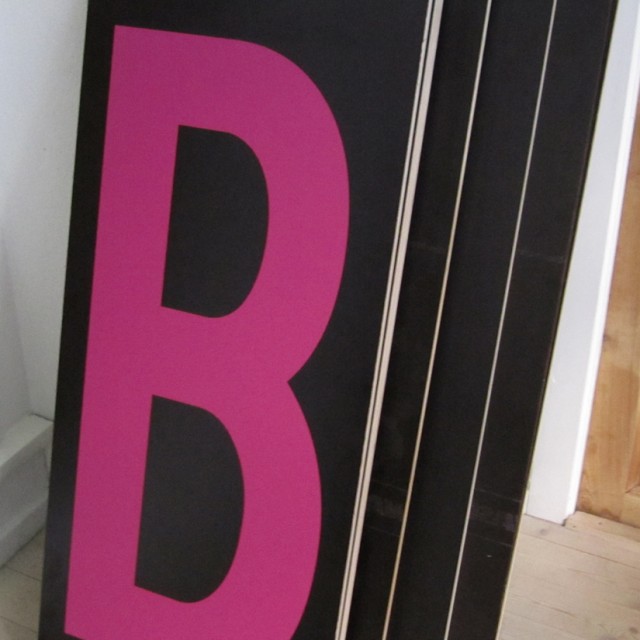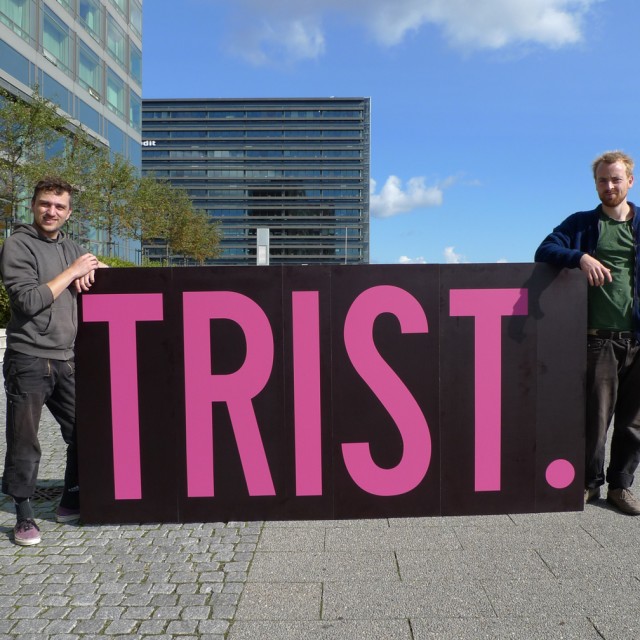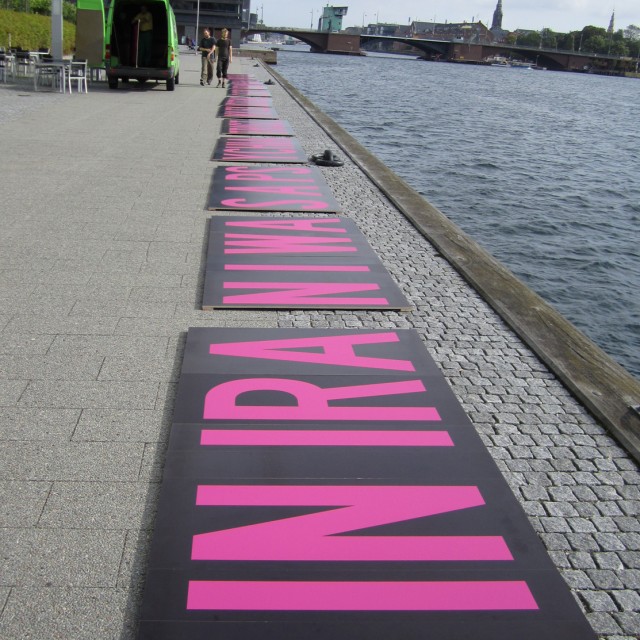Giving Harbor (Part 1 of 3)
We have a deep interest in working in public spaces, of making art that lives outside of the elite, privileged spaces of artistic reception, and dwells in the world in many diverse ways. From time to time, we will report on our own individual projects within the context of the Mythological Quarter.
Giving Harbor is a large public project I initiated several months ago, here in Copenhagen, with the support of a local group of artists and curators who call themselves publik. publik is currently Katarina Stenbeck, Johanne Løgstrup and Nis Rømer. They have been supporting the production of ambitious public art projects in Copenhagen for many years: www.publik.dk.

The sign system is comprised of many individual letters, 1.25 m tall, with varying widths.
The first installment of Giving Harbor appeared in Copenhagen’s harbor from September 16-October 22, 2011. The installation was a sign system comprised of many individual letters mounted on the harbor’s wooden moorings. The message was generated in collaboration with the users of Trampolinhuset and contributors to visAvis magazine, which “focuses on migration and asylum, produced by people with or without citizenship living in Denmark.”

Rasmus Pedersen (left), Peter Olsen (right), and Jonas Georg Christensen helped with the installation of the sign. Jonas took this photo. The sign was made in sections that were easy to manage, transport and install. One chunk accidentally ended up being the Danish word “trist” that translates to “sad”. Peter joked that this could become his new graffiti tag.
Giving Harbor’s interchangeable letters can be used to make an unlimited number of large-scale public signs. We had initially planned on putting out three phrases in the first iteration, but that became untenable given time, money and labor constraints. Plans are to put the system back out next summer.
A key reason for initiating Giving Harbor is that the shared spaces of cities exclude signs and messages from people who do not have power or money. To put your sign up on a building or beside a road on a billboard, you must have these things. If you do not, you are not allowed to insert whatever you want into these spaces. If you try to, your sign will be removed and you could face arrest. In this way, these spaces are deeply undemocratic. Giving Harbor was conceived as a way for different groups who do not hold power within the dominant culture to express their concerns in a strong, very public manner.

Unloading the sign and preparing for installation just before being stopped by the hotel’s head manager
On the first day we tried to install the sign system, security guards and managers from the Marriott hotel came out to talk to us. We had permission from the hotel to put the sign up on the mooring in front of their building so we thought there would be no problem. This did not stop the head manager from shutting down the project temporarily. He didn’t explain the reason to us, we just got word from the person who had initially given us the go ahead that we would have to stop. The hotel offered us the option of storing the sign and that we could put it up after the national elections that were taking place that week. Initially, this was a deeply frustrating and disempowering situation that produced several sleepless nights and a lot of anxiety on my part.
Go to Part 2 of Giving Harbor.
Project Thank-yous:
I want to personally acknowledge and thank Tone Nielsen, Morten Goll, Søren Rafn, Liv Duvå, Rasmus Pedersen, Sami Saabet, Faruz, Mohammed, Carlos, Stan, and many of the great folks who come to and use Trampolinhuset and discussed this project with me. Thanks to Jonas Georg Christensen, and especially to Peter Olsen for his terrific production work and mad skills. Big thanks to publik and Kristofer Hultenberg for production of the vinyl letters and taking photographs of the installed sign. I also owe thanks to the fine folks at visAvis magazine who have been very supportive of this project. It would not have been possible without their support.
Radio Aktiv Sonic Deep Map (2013)

SUPERKILEN – Extreme Neoliberalism Copenhagen Style

Read Brett's essay about the park.
Download our guide:

This is our guide to how-to books from the counterculture of the 60s and 70s. Click to get the download page.
Categories
- Agriculture (11)
- Animal sounds (1)
- Artist parents (19)
- Arts and culture (106)
- Bees (3)
- Book reviews (14)
- Books (18)
- Critical essays (5)
- Daily Photo (5)
- Design (36)
- Dirt (11)
- Environmental activism (43)
- Exhibitions (24)
- Farms (11)
- Forest (7)
- Friday connect (15)
- Growing (42)
- Habitat (38)
- Homesteading (16)
- Interviews (15)
- Kitchen (14)
- Living structure (9)
- MISC (15)
- Mythological (2)
- Neighborhood (83)
- Ocean News (1)
- Our Art Work (21)
- Personal – Design/Art (3)
- Play (2)
- Playground (4)
- Projects (21)
- Public space (53)
- Resilience (13)
- Sea Side (2)
- Sojabønner (2)
- Tofu (8)
- Vermont correspondence (7)
- Water (3)
- Wednesday picture (31)
- Workshop (1)
Video interview:

Watch our interview of SeedBroadcast, a mobile project that is part seed library and part seed-saving-story-collecting machine-recording the stories of seed saving, farming, and food sovereignty work being done around the US.

Download a poster Bonnie made about biodiversity in a vacant lot in the Amager borough of Copenhagen, in collaboration with biologist, Inger Kærgaard, ornithologist, Jørn Lennart Larsen and botanist, Camilla Sønderberg Brok: A BRIEF TAXONOMY OF A LOT

We made and installed a network of bat houses in Urbana, Illinois, to support the local and regional bat population, but also to begin a conversation about re-making the built environment.
READ MORE
BOOK REVIEW:

We write often about artists and art groups that work with putting ‘culture’ back in agriculture. Here is a new favorite: myvillages, a group of three women based in Germany, the Netherlands, and the UK. Read more...

Post Revolutionary Exercises
We really admire the dedicated hard work of Kultivator who seeks to fuse agriculture and art in their work. Click this sentence to get a PDF of their poster collection called "Post Revolutionary Exercises."

Cultural Practices Within And Across
This amazing book networks urban and rural resilience and sustainability projects around the world. Deeply inspiring projects in Romania, Paris, San Francisco, and elsewhere.
• Read our review of the book.
• Buy the book.
• Download the book.







